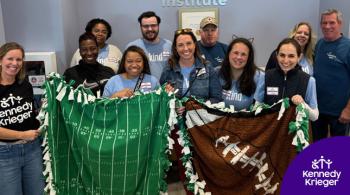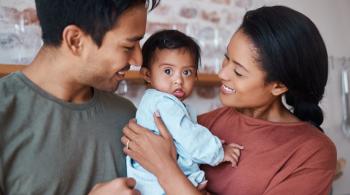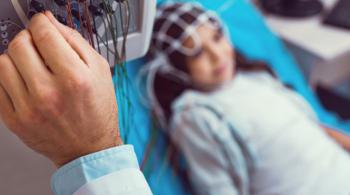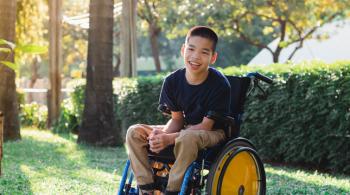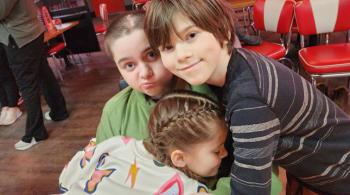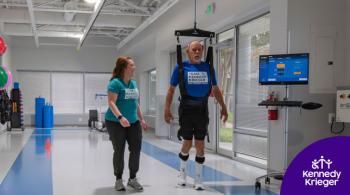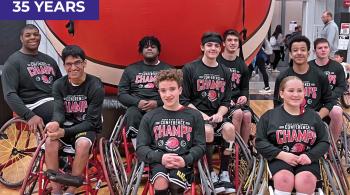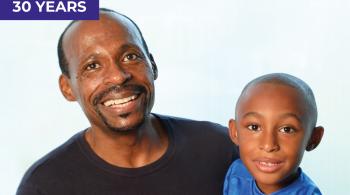Exploring Neuroplasticity: How Early Childhood Shapes Brain Development and Learning
Early childhood is an important stage of life for brain development. As a child learns new information, engages in social interaction, and goes through their daily routine, their brain responds with neuroplasticity, a process that allows it to change, adapt, and reorganize. Listen to Dr. Brad Schlaggar, president and CEO of Kennedy Krieger Institute and his guests, Drs. Joanna Burton and Gwendolyn Gerner, as they discuss neuroplasticity in early childhood and its role in brain development and learning.
Learn More About Kennedy Krieger Faculty & Staff Members Featured in This Episode
Learn More About Kennedy Krieger Faculty & Staff Members Featured in This Episode
View Episode Transcription
Dr. Brad Schlaggar (BS): Welcome to Your Child's Brain, a podcast series produced by Kennedy Krieger Institute with Assistance from WYPR. I'm Dr. Bradley Schlaggar, pediatric neurologist, and president and CEO of Kennedy Krieger Institute. Because of the fundamental role our brains play in making us who we are, how we think, feel, communicate, move, and interact. It can be no surprise that how our brains develop has a great deal to do with how we emerge as individuals. Healthy brain development is paramount to a healthy life. As discussed previously on this podcast, we know well that the earliest period in a child's life, namely the first years, constitutes the foundation for a healthy developmental trajectory for a child. The full course of brain development plays out over the first two decades of our lives, but that first period has an outsized impact on both typical and atypical development. Now, one of the most remarkable features of the human brain, especially during its development, is captured by the concept of neuroplasticity. The term plasticity, attributed to the famed psychologist William James and dating back to the late 19th century, refers to the ability of the brain to change in response to inputs or experience. The concept started to take hold in the mid to late 20th century as experimental approaches to neuroscience began demonstrating such change directly, especially during development. As a child learns new information, engages in social interaction, and goes through their daily routine, their brain actively forms new neural connections that allow it to change, adapt, and reorganize. This response within the brain is what we refer to as plasticity or neuroplasticity. One helpful way to think about plasticity is that we have both experience-expectant and experience-expectant forms. For example, in typical development, the human brain is exquisitely capable of developing any spoken language so long as we are exposed to that language. Language development, per se, is experience-expectant. But of the over 7,000 languages in the world today, the specific language a child learns is entirely dependent on which language that child is exposed. Thus, which language we learn is experience-dependent. Importantly, we can see evidence of the brain changing and responding to inputs and experiences even in the prenatal period, while still in utero, as well as postnatally, including for babies born prematurely, who often have multiple clinical challenges in the first weeks or months of life. Now, both in the perinatal period and beyond, neuroplasticity can be influenced by myriad factors, including sleep, nutrition, activity, environmental factors, and, of course, genetics. For parents, day-to-day and moment-by-moment engagement with their developing child and language, social interactions, play, and other activities that reinforce functions and skills can go a long way in facilitating that adaptive neuroplasticity. In this episode of Your Child's Brain, we will discuss the importance of neuroplasticity in early childhood, how brain development is affected by factors such as sleep, activity and nutrition, and the role parents and caregivers play in shaping plasticity. We'll also cover recent research trends around this crucial aspect of childhood development. Joining me today are two of my exceptional colleagues from Kennedy Krieger Institute. Dr. Joanna Burton is a developmental neurologist at Kennedy Krieger and an assistant professor in the Department of Neurology at the Johns Hopkins University School of Medicine. She co-directs the Infant Neurodevelopment Center at Kennedy Krieger and the Study on Perinatal brain injury Recovery and OUTcome. The acronym is SPROUT, a research collaborative. In addition, Dr. Burton serves as the medical director of two of Kennedy Krieger's Centers, including the Early Childhood Development and Education Center, as well as the Child and Family Support Center. Dr. Gwynn Gerner is a developmental neuropsychologist at Kennedy Krieger and an associate professor of Psychiatry and Behavioral Sciences at the Johns Hopkins University School of Medicine. She's the co-director of the Infant Neurodevelopment Center at Kennedy Krieger, and the co-director of SPROUT. Welcome, Joanna and Gwynn. Gwynn, in the introduction, I did talk a bit about neuroplasticity, its background, its history. But can you define it further and share how you think about it?
Dr. Gwynn Gerner (GG): Absolutely, Brad. First and foremost, Joanna and I want to thank you for having us here to discuss this really important topic. When we think about neuroplasticity, it really is a fascinating and complex process that we continue to learn about in neuroscience. It really involves brain cells or neurons, and the way these cells come to be and then connect with each other throughout the brain over the course of the entire lifespan. It forms the foundation for how information from the senses can come into the brain, different areas of the brain can communicate to process that information, and then how the brain sends responses back out to the body, resulting in many different types of behavior. Really, neuroplasticity is so important for how we learn. When I think about neuroplasticity, there are several different types of neuroplasticity, including adaptive, impaired, and maladaptive plasticity. Adaptive plasticity is often the one we hear about and think about the most, and this really involves the organization or sometimes the reorganization of neural connections in the brain to maximize function. For instance, if we think about a child learning to play a stringed instrument, we can actually see changes in the brain as they learn that instruments, such as the sensory motor cortex, opposite to the hand that they're putting on the strings, actually increase in size as they practice and become quicker and more fluid in playing their instrument. When we think about other forms of plasticity, like impaired plasticity, we often think about the genetic and biological factors that disrupt those neural connections and disrupt the refinement of good neural connections. One example of this might be early brain injury that leads to cerebral palsy or CP. Ultimately, young children have large neural connections or tracks on the same side and opposite side of the body that underlie their motor movements. But then, through experience in early childhood, those connections become more refined, and what we tend to see is that the connections to one side of the body and the opposite side of the brain become stronger, and the connections on the same side of the body and the same side of the brain become less and less evident over time. However, when there's an injury that occurs, as in the case of somebody who developed CP, those connections get disrupted, and we don't necessarily see that refinement where we get those cross-body brain connections that run. Instead, things really become abnormal, and they ultimately result in abnormal movements like we see in cerebral palsy. Finally, when we think about maladaptive neuroplasticity, we think about something that went wrong and how the neurons function and how the connections in the brain were made. Maladaptive neuroplasticity may underlie conditions like epilepsy, autism, and schizophrenia. In these conditions, there's problems with the connections that are made in the brain and then how the cells ultimately communicate, and that stays in place over the course of the lifespan.
BS: Joanna, just picking up on those themes, there's a lot going on developmentally in typical development, and then there can be a response to some injury or adverse environmental factor. Can you talk a bit more about, maybe at the mechanistic level, what's happening? Then we often hear that the developing brain has more opportunity for plasticity than the older brain, and how mechanism may be involved in that transition that happens with capacity for plasticity.
Dr. Joanna Burton (JB): Absolutely, Brad, to follow in on what Gwynn was talking about, neuroplasticity happens at multiple levels within the brain development at a cellular level and a mechanistic level, but also on a connection level. Each of these impacts, how our cells connect and how they then develop in the brain. What you heard Gwynn talk about was that some of that can be very positive in how we learn as connections get stronger. In the neonatal and in the first three years of life, those connections are building. We have many, many synapses or connections, and those cells are growing, and so the brain development is very big during this period of time. While we continue to have neuroplasticity throughout our lifetime, as brain development starts to slow after those first few years, we also have pruning. We can't keep the energy that's needed to keep all of those cells going long term. We start to specify where those connections are. To be the things that we do most often or that we need the most. This means that the rate of neuroplasticity goes down, but as you mentioned, can continue even into adulthood, and there's parts of our brain that actually don't fully continue that process until much later in life, even into our 20s. In the early period, the sensory aspects are the most robust, our auditory and sensory systems, really in those first few months, with our motor and sensory system coming in. Things like our prefrontal cortex or our ability to plan, organize, shift, stop ourselves, often doesn't get fully developed really into our 20s with anyone with a teenage child knows about. The other interesting piece about this is that there's ongoing research now to help us think not just about how those pathways happen naturally, but are there things we could do to reopen periods of time when a period of neuroplasticity has started to close or become less available, where we could potentially help in some of those other areas of neuroplasticity that Gwynn talked about, the impaired maladaptive neuroplasticity, for example.
BS: Both of your responses really reinforce the importance of early childhood period for atypical brain development. Gwynn, can you talk some more about how it is that experiences and exposures really drive development in those early years and the interaction with plasticity mechanisms?
GG: So really, like Joanna was talking about, the brain is really under its most active period of construction during early childhood or this birth to five period. As she discussed, there's more neurons and more potential for neural connections available than we ultimately will use in the long term during this early childhood period. Because of it that, it's really this rapid period of development with the greatest potential for learning, and also the greatest rate of developmental skill acquisition that we see over the course of life. For instance, like you pointed out in the introduction, in terms of language learning, we have this great potential to learn language and multiple languages when we're really young. As we know from experience, if you are an adult learner of a second or third language, it is much harder to learn, whereas when you expose a younger child to languages, different languages, multiple languages in this birth to five window, they are more likely to learn that language and learn it really fast. Additionally, they're actually more likely to speak it like a native speaker. Essentially, they are a native speaker at this point. The way they pronounce things, the accents, all of that is much closer, if not completely consistent, with a native speaker versus an adult learning a language. They can learn all of the rules of the language, they can learn how to say things pretty close to pronunciation, but it may not sound exactly like a native speaker. That really speaks to the fact that these experiences that you get early in life, when this neuroplasticity, when the brain is under such active construction, can get learned much quicker and much more fluidly in a child than they might in an adult.
BS: Joanna, in the introduction, I talked about this, even in the perinatal period, even before birth, there's evidence of plasticity occurring. When you think from a clinical standpoint, when you're interacting with pregnant moms who are thinking about the best possible outcomes for their child, what advice do you give, and how do you think about the best ways to help ensure as healthy a brain development as possible in that period?
JB: I think one of the critical pieces that we think about when we're thinking about even that prenatal period is that the brain is genetically set to continue neuromaturation, no matter what is happening around it. But big environmental influences can disrupt that pathway. What we want moms to do is really be taking good care of themselves. The fetus is in a fluid-filled sack. It's getting nutrition through the mom's nutrition. A parent who is taking good care of themself, eating very healthy foods, full of those good fats that we hear people talk about, who's getting a moderate amount of exercise, limiting the stress that they experience, all leads to a healthy environment for that brain to be developing in. Additionally, we know that the fetus is experiencing stimulation during that period of time, particularly in later trimesters. We know that babies, when they are born, can actually differentiate their mom's voices from strangers' voices through research studies because they've been exposed to that language continuously through the pregnancy. We also know that if you modify that voice so that it sounds like it's coming through fluid, they understand it even better because that's the experience that they've had once the auditory cortex has started to process sounds. This means that talking and communicating, continuous movement, these are things that allow a baby's brain to continue to develop appropriately during that prenatal period.
BS: Joanna, sticking with you and Gwynn, of course, comment if you'd like on this question. Prematurity with or without evidence of direct brain injury has implications for developmental outcomes. Can you talk us through some of the reasons why that's the case? How is it that prematurity, again, with or without direct evidence of brain injury, can have adverse consequences on ultimate brain development?
JB: As I mentioned, in the prenatal period, there's a perfect milli u to allow that brain to be developing. When that is interrupted, for example, by a premature birth, the fetus continue to develop outside of that perfect environment. That means the environment can be both overstimulating and understimulating. The baby no longer has continuous contact with the mother. The baby no longer hears voices or their mom's voice all the time. Instead of a fluid-filled sack, air and a hard surface, and an incubator are what the baby's body is responding to. We have necessary, but sometimes painful touch to keep a baby alive in a NICU instead of the continuous soft fluid that they were bathed in and feeling the touch of before. These things can make, although the genetic pathway allows for neuromaturation to continue, it's happening in different circumstances. This means that parents have the opportunity to try to replicate as much as possible some of those things we know promote good brain development. Even when a baby is so sick that the baby cannot be touched, parents' voices can be incredibly soothing and incredibly helpful. We use a variety of research-based programs in our NICU to help parents have that presence for their children, including even things like what we call hand hugs, touching their head, or just touching their hand in a safe way if it's not available for full touching. Once a baby is able to have skin-to-skin contact. The babies actually resting with their parents skin to skin has been shown to regulate their heart rate, their respiratory rate, and improve outcomes. That contact with what would be those normal experiences can really promote that ongoing neuro maturation and enhance the good forms of neuroplasticity. Gwynn, what else would you add?
GG: I think when we think about the pre-term brain and how it develops, I often think about it and talk to parents about it is it's always for children a time of active construction for the brain. But construction may look different, your brain is developing different. For children who are born preterm, both with injury we can see on imaging and without injury, we see on imaging. What we do know is the way those connections in the brain are formed are really different through this construction process. I often describe it to parents as when signals are being sent throughout the brain and children who are born preterm, it's like driving through the city where everything's under construction during rush hour. Ultimately, those signals may get to their destination, but you're going to drive on some really bumpy roads that have potholes, and you're going to be rerouted, and there's going to be gridlock and all of those things. The end result in what we hear, oftentimes by the time children get to this toddler preschool age, is, they take so much longer to respond to things when I ask them questions or when I ask them to do something. This is really why is because during this period, again, neuroplasticity has worked to create connections. There's just fewer of them. Some of those connections aren't as good as they would have been under the most optimal circumstances.
BS: Well, that's a vivid description of how maladaptive and adaptive neuroplasticity may play out. Keeping with the environmental exposure theme, after this baby is born and is exposed to the world, Gwynn maybe start with you. Let's talk about some of those environmental factors that can have direct implications for development and plasticity.
GG: Sure. When I think about this, it always takes me back to Maslow's hierarchy of needs. Really, those basic factors are so important for physiological stability and good development, making sure you have shelter and safety and food. Those really serve as that foundation. Also, sleep is particularly critical and rest, as well as physical activity. We need all of those things to really be physiologically balanced. Without that physiological balance, it's really hard for all of the good work in terms of neuroplasticity to be taking place. In terms of other factors, certainly having an environment that is enriched is really important. But that doesn't mean having the latest and greatest toys or being enrolled in every possible program. It can be very, simple. We've done a lot of discussing language, but really talking to your child is so important. That doesn't have to be something that is in a formal teaching setting. It can be in the grocery store, talking to your child as you're going grocery shopping and describing things that you're doing. It can be reading to them at night. Then it's really important to think about different types of play opportunities. Again, we don't need the latest and greatest toys. You can pull out some pots and pans. They can be instruments. They can help you pretend to cook and engage with your child in those ways. Blankets and boxes for forts are absolutely magical and really stimulate the imagination. All of these real-world experiences and interactions with parents, opportunities to have real-world exchanges with peers in parks and on the playground are absolutely so important. That really comes in contrast to trying to limit some of that screen time, that two-dimensional time where we don't have that really nice back-and-forth reciprocal interaction with other human beings that makes us have to adjust our behavior and learn. When we think about the environment and really how to maximize neuroplasticity for all children, those are some really important things I think about.
BS: Joanna, a theme that we've talked about in this podcast over the years has been that nature versus nurture or genes versus environment. It's the wrong way of thinking about development. It's really an interaction between genetics and environmental factors. I like to think of it as a cascading interaction that plays out over time. I'm interested in how you think about it. How do you think about this relationship and the interaction between genetics and environment shaping a child's brain development?
JB: I think that genetics provides the roadmap for what's going to happen, but it's those environmental experiences that shape what the brain and what the child's brain, how it grows, and what are the pathways that become the most important pieces for that. Even in an injured brain, our body really specializes to make sure we can do those things that make us unique, often sacrificing efficiency, as Gwynn talked about, to make sure that we can talk, that we can move our bodies, that we can interact with people. That's some of that hard work that the brain does in reconnecting, even if there is a pothole or a one-way street. What that means is that it's incredibly important for all children to make sure that the environment promotes those areas that will lead to the most success. As Gwynn talked about, that really comes through interaction with the environment. As we've talked about language, the same thing happens with the motor system. All children benefit from an opportunity to work on what we call tummy time, lifting their head and chest, developing neck and trunk control. That interacts with both the genetics and the environment because the way our bodies myelinate or provide insulation over our neurons, which makes our signals go faster and faster, is top-down. Our head and our neck, and then our trunk down to our legs, it's length-dependent. If we're working on things like standing when a baby is very young, that means that we're actually interacting with a reflex, and they're not actually using their legs to try to stand. But if we're working on resting on our stomachs and lifting our head and working in supported sitting, this is where our body is ready to start developing the connections and strengthening those muscles. I think the same thing is true in other areas as well, but that's just an easy way to see how the brain and the genetics are really interacting.
BS: Joanna, we often hear about critical periods or these particular windows of opportunity for learning certain skills or domains of function that are optimized during those periods. Can you speak to what are critical periods or windows of opportunity? Do those windows close gently, or do they slam shut for opportunities to learn?
JB: It's an active area of research. Critical windows seem to be very genetically predisposed to laid down in one pathway. However, there's a sensitive period around those critical periods where, with the right environmental stimuli, there can still be growth in those areas, even if it's not as fast in response to the exact signal that it needs. These sensitive periods can last for much longer times. To that question, it's a much slower window of closure, where you might not get the peak response of learning, but you can continue to learn in different areas in those sensitive periods.
BS: Gwynn, Joanna made the point that genetics laid out a roadmap, and she made the point. It's also the case that experiences and exposures can override genetic roadmap or predispositions. Can you speak through some other examples of how that can happen that experience overrides even a strong genetic predisposition?
GG: I often think about there's a variation on this, and you can get moderation of genetic risk. Sometimes we can override genetic risks and things along those lines. I think one of the easiest ways for me to think about it is when I think about somebody who actually has a genetic condition where we know it's going to affect how you think and how you problem solve or your cognition over the lifespan, and there's a really high risk for intellectual impairment. What we see is when we can get a child who's younger into early interventions and really work on building consistent, good daily routines, getting some really important early social exposures that allow a child to really learn very formally and informally how to be a citizen in their community, and all of those pieces come together, we can kind of moderate the degree of impact that that genetic condition might have, overall, where we might have seen a more moderate intellectual impairment later in life. Maybe we'll see a milder one later in life, because we've put all that scaffolding in place early on to really maximize the neuroplasticity and give these optimal environmental exposures, supports and interventions.
BS: Important experiential factors also include nutrition and physical activity. Joanna and Gwen, too, if you'd like comment further on what roles do things like nutrition and activity play in development and plasticity?
JB: As we mentioned early on, neuroplasticity and that huge burst of neuron growth and connection growth that happens in those first few years of life takes a lot of energy. It's very important that the building blocks for that growth, which comes from our nutritional system are really healthy during that period of time. I mentioned those good fats that our brains need, but also a lot of the vitamins and minerals that we get through healthy nutrition and healthy foods are what allow the brain to develop in that period. When mentioned also, really having to meet those basic needs in the beginning is what allows further development and learning to occur. Making sure that we have a good nutritional base is really critical. This is complicated during the toddler period because toddlers can love something one day and not love something the next day. They can eat as much as you and I on one day and nothing the next day. We often talk to families about the fact that you have to think about your child's nutrition over a handful of days rather than meal by meal, or you'll become preoccupied, and it'll really stress you out. The nutrition, while it plays a critical role, has to be looked at from a higher level and not just on a single meal level. Physical activity is similar critical, both for how our bodies develop and keeping us healthy, but also because it's through moving our bodies that we get the sensory system, our sensory system gets feedback for our motor system. We call this proprioceptive feedback, where our joints are in space. This is an incredibly critical part of how children learn about their world. Their cause and effect, how they have input into the world and how the world has input back into them. Making sure we have the opportunity for physical activity, both for the cardiovascular benefits and for our brain benefit, but also for the experiential part of things, figuring out where we are in space and how we're interacting with our environment.
BS: Gwen, I want to return to a point you made earlier about how experience and exposure can moderate, for example, genetic predisposition, even a strong genetic predisposition for a particular outcome. But let's talk some more about how neuroplasticity mechanisms can help children catch up if they have developmental delays, per se. I know you focus on your world as a neuropsychologist in the infant period, but thinking broadly across the developmental trajectory, talk to the critical role that neuropsychology and its assessment and as a way to set up intervention can help optimize a developmental trajectory for a child.
GG: Sure. Thinking about it from under a psychological perspective, certainly, when I'm seeing kids in clinic and we're looking at potential delays in development, really, my goal is to watch them both informally and then to really engage them in play. Now, that play is actually me doing an assessment. They don't know that, and that's the most important part, but I want to see how they play, how they interact, what they can do, and what they can't do. Then, for the things that they can't do, I want to see if I add in some extra support as I'm assessing them, how much support it takes us to get them to be able to do something. That could be me asking them to tell me what a picture is, and if they can't come up with the word, maybe I give them the first sound of the word and see if they can come up with the word. If it is placing something where I need them to place it, and I don't see that happen. Can I support them at their elbow? Can I tap around where they need to put it and just see if they can learn those things? That's the assessment portion, which then really helps me think about where there are gaps that need more support and where there are strengths and how we can use those things together to help in development. For a young child, one of the places that we often see this is young children tell me a lot about what they know through showing me how objects and people relate in space. It's called visual perceptual skills. That's how they do a lot of their active learning when they're young, and a lot of their active demonstrating of what they know. When there are difficulties with these visual perceptual skills, we often see that within the context of motor delays. That's because a child can't move around the way they need to in their environment to learn about their actual spatial world. We know we can pick kids up and show them things at different angles and all sorts of things, but that really doesn't help with learning about how objects relate in space, unfortunately. It is really that active effort to engage with things, move towards them, move around them, that teaches us about things in space, and to explore that. I really often rely on my colleagues in physical therapy and occupational therapy to help in this way too, and help support those gaps and development of learning how to move to things, move around and move their bodies, which is so important for learning. As well as how to really begin to engage their hands and their fingers so they can pick things up, turn them around, and explore them, and learn how to problem solve with those kinds of skills. As children get older, we do a lot more looking at language that comes on a little bit later than some of those motor and visual perceptual skills that we look at so much in the first year of life. At that point, I'm beginning to look at how your complexity of sounds is developing, and then how that starts to translate into your expressive vocabulary, the words that you have, your receptive vocabulary. If I say something, can you show me what it is? These are really important foundational milestones, these language milestones for lots of big language skills when we get older.
BS: What you just described, one of the things I just want to pick up and highlight is often these domains of cognition and function are thought of as silo separate. That the motor system, you highlighted how important it is for the motor system, not just per se, but also interacting with the development of all these other cognitive and functional domains. I think it's a great point to emphasize. I'm going to go to the last question, which is often my favorite one, favorite for guests as well, to talk about what you see as the most exciting directions and research in your area. Joanna, maybe start with you, and then Gwen, talk about excitement in the research domain.
JB: I think one of the pieces that excites me most is this opportunity to think about how we can expand those windows of neuroplasticity and how we can write or correct some pathways when we've had some difficulties with them. The birth to three period or the birth to five period is so exciting, not just because the brain itself has the most opportunity for neuroplasticity, but because we're building those foundational skills that Gwen just talked to you about. We're not just having a child learn how to do the motor skill or the visual skill or the auditory skill, but we're building the foundation of their thinking skills later on. Their learning cause and effect. Even as they're just trying to reach for things. To me, the area that I'm most excited about is where those two things intersect, and we're providing early intervention opportunities for children who've had more atypical development or where the neuroplasticity might be impaired. What we've found thus far is what Gwen mentioned: the active goal-directed, child-directed activities are what are making the biggest differences. There's a lot of exciting work being done right now, integrating some fascinating and very cool neurologic tools like TMS or electrical stimulations with goal-directed activities that can allow children to really do some rewiring in very exciting ways. I think for parents, some of that translates into what Gwen talked about, making sure that we're constantly interacting, that we're providing not necessarily expensive, but a stimulating environment through what's happening around them.
BS: The TMS that Joanna mentioned is the transcranial magnetic stimulation. Very intriguing direction the field is heading. Gwen, your thoughts?
GG: I think it's a really exciting age group to think about research and new opportunities for intervention with. As a neuropsychologist, it's an age group that neuropsychologists don't commonly work with. It is becoming more of an area of interest, I think, around the world for neuropsychologists, and I'm really glad to see that. But for me, it's an area where we've stagnated in terms of the types of assessments we have available to do with children. I think there's a really rich opportunity to think about development of assessments for young children that can be done efficiently. You only have so long to work with kids in this age group and maximize what you get, and really good, reliable and valid instruments are worth their weight and gold because that's our ability, in addition to using our clinical judgment, that's how we collect the data to understand where there are gaps in development and where we need to intervene. I think that's a really exciting area for me, as well as the possibility of then developing more and more evidence-based strategies to intervene for young children, to really support their development and moderate those risk factors that they may have.
BS: Well, that's a great place to end. Thank you to our guests, Dr. Joanna Burton, and Dr. Gwendolyn Gwyn Gerner. We hope that you, our listeners, have found this discussion interesting and informative. Please check out our entire library of topics on your child's brain at wpr.org, KennedyKrieger.org/Ycb or wherever you get your podcasts. You've been listening to Your Child's Brain. Your child's brain is produced by Kennedy Krieger Institute with assistance from WYPR and producer Mark Gunnery. Please join us next time as we examine the mysteries of your child's brain.




